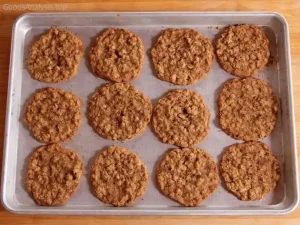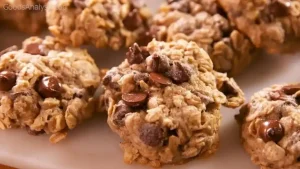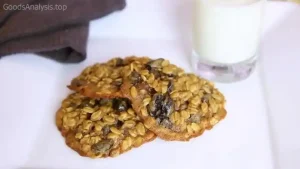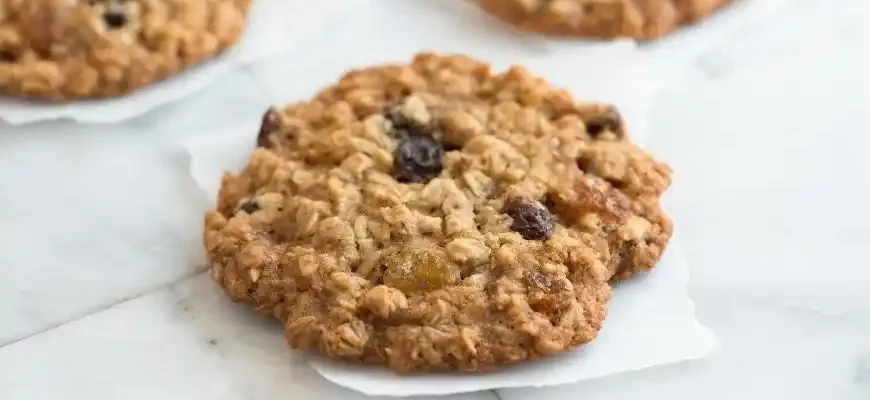Oatmeal cookies: A classic treat that bridges generations, brings comfort, and even packs a bit of nutrition, depending on how you make them. Whether you’ve been baking these cookies for decades or are trying them for the first time, there’s always something new to learn. This guide provides an in-depth look at how to make oatmeal cookies, exploring not just the ingredients and methods, but also the nutritional benefits, some potential pitfalls, and ways to improve your recipe.
At 50+ years old, I’ve made my fair share of oatmeal cookies, and I’ve learned quite a bit about them over the years. So, let’s get down to it, whether you’re a seasoned baker or just starting out!
What’s in an Oatmeal Cookie?
At the most basic level, oatmeal cookies are made with oats, sugar, butter, flour, and eggs. But the beauty of oatmeal cookies is in their versatility. You can adjust the ingredients to suit your dietary needs or flavor preferences. Here’s a breakdown of the key ingredients:
- Oats – The heart and soul of oatmeal cookies. Whether you use old-fashioned rolled oats or quick oats is up to you, but rolled oats tend to offer a chewier texture, while quick oats will give you a slightly softer, more tender cookie.
- Butter – Adds richness and flavor. Some recipes use margarine or vegetable shortening as substitutes, but nothing beats the taste of real butter.
- Sugar – You can use brown sugar, white sugar, or even a mix of both. Brown sugar will give the cookies a deeper, richer flavor and a more moist texture, while white sugar creates a crisper cookie.
- Flour – All-purpose flour is the most common choice here, but you can experiment with whole wheat flour for a heartier, more fibrous texture.
- Eggs – They help bind the dough together and give the cookies structure.
- Baking Soda – This is the leavening agent that makes the cookies rise slightly and become light and airy.

And then, of course, there are all the fun add-ins—chocolate chips, raisins, walnuts, or even coconut flakes—that can elevate your cookie recipe to the next level.
The Health Factor: Is Oatmeal Really That Good For You?
Oats, the star of the show, bring a host of health benefits. As a whole grain, oats are a rich source of soluble fiber, specifically beta-glucan, which has been shown to help lower cholesterol levels. So, if you’re making your oatmeal cookies with good quality oats, you’re already giving your heart a little help.
Oats also provide sustained energy. The fiber slows the absorption of sugar into your bloodstream, which helps maintain stable blood sugar levels. This is important for managing energy throughout the day, especially for those who need to watch their blood sugar levels—think of diabetics or those with metabolic syndrome.
But here’s the caveat: cookies are still cookies. While they may have some health benefits, adding too much sugar, butter, or other sweeteners can negate those benefits. So, like everything, moderation is key. For a healthier take, you can substitute some ingredients like using unsweetened applesauce instead of butter, or reducing the sugar content without losing the flavor.
Step-by-Step Recipe: Classic Oatmeal Cookies
Now, let’s roll up our sleeves and get baking! Here’s a simple and reliable oatmeal cookie recipe that anyone can follow.
Ingredients:
- 1 cup (2 sticks) unsalted butter, softened
- 1 cup brown sugar
- 1/2 cup white sugar
- 2 large eggs
- 1 teaspoon vanilla extract
- 1 1/2 cups all-purpose flour
- 1 teaspoon baking soda
- 1/2 teaspoon salt
- 3 cups old-fashioned rolled oats
- 1 cup raisins or chocolate chips (optional)
- 1/2 cup chopped nuts (optional)

Instructions:
- Preheat your oven to 350°F (175°C). Line two baking sheets with parchment paper for easy cleanup.
- Cream the butter and sugars: In a large mixing bowl, beat together the softened butter, brown sugar, and white sugar until the mixture is light and fluffy. This process takes about 3-4 minutes, so don’t rush it!
- Add the eggs and vanilla: Crack the eggs into the bowl, one at a time, and beat well after each addition. Stir in the vanilla extract.
- Dry ingredients: In a separate bowl, whisk together the flour, baking soda, and salt.
- Combine wet and dry ingredients: Gradually add the dry ingredients to the wet ingredients, mixing until just combined. Be careful not to overmix.
- Add the oats and extras: Fold in the oats and any mix-ins like raisins, chocolate chips, or chopped nuts. If you want to get creative, you can also add shredded coconut or dried fruit.
- Scoop the dough: Using a cookie scoop or tablespoon, drop rounded balls of dough onto the prepared baking sheets, spacing them about 2 inches apart. These cookies don’t spread much, so you don’t need to worry about them merging together.
- Bake: Place the cookies in the preheated oven and bake for 8-10 minutes, or until they are golden around the edges. They may seem a little soft in the center, but they’ll firm up as they cool.
- Cool: Allow the cookies to cool on the baking sheet for a few minutes before transferring them to a wire rack to cool completely.

Common Mistakes and How to Fix Them
Making oatmeal cookies isn’t rocket science, but even seasoned bakers can make mistakes. Here are a few common ones:

- Cookies are too dry: If your cookies come out dry, you might have over-baked them or used too much flour. Next time, measure your flour more carefully and don’t leave the cookies in the oven longer than needed.
- Too crumbly: If your cookies crumble too much, it could be that the dough is too dry or you didn’t add enough binding ingredients (like butter or eggs). Try adding a little extra butter or even a spoonful of yogurt or applesauce.
- Cookies are too flat: This can happen if you used melted butter or didn’t chill the dough before baking. Always use softened, not melted butter, and consider chilling your dough for at least 30 minutes.
- Too sweet: If you prefer a less sweet cookie, reduce the sugar by 1/4 cup or substitute with a natural sweetener like stevia or monk fruit.
Nutritional Considerations
Oatmeal cookies can be a surprisingly nutritious snack if you’re mindful of the ingredients. As mentioned, oats are a good source of fiber, but you can amp up the nutritional value by adding things like flaxseeds, chia seeds, or even a scoop of protein powder. If you’re cutting back on sugar, you can substitute it with a natural sweetener like honey or maple syrup, though this will affect the texture and flavor.
Nutritional Breakdown (per cookie):
- Calories: 120
- Fat: 7g (saturated fat: 4g)
- Carbohydrates: 15g
- Fiber: 2g
- Protein: 2g
- Sugar: 8g

Reader Opinions on Oatmeal Cookies
Here’s what some people from different walks of life think about oatmeal cookies:
- Emma, 32, USA – “I love oatmeal cookies because they’re the perfect balance of chewy and crunchy. I add a bit of cinnamon and some chopped walnuts. It’s my go-to comfort food after a long day.”
- Carlos, 54, Spain – “I’ve been making oatmeal cookies for years. I like them with a cup of coffee in the morning. I’ve noticed that using whole oats and cutting back on sugar makes them a healthier treat.”
- Nina, 45, India – “Oatmeal cookies are a staple in my house. I make them with jaggery instead of sugar for a traditional Indian twist. The result is delicious and slightly healthier too.”
- Sarah, 22, UK – “I make oatmeal cookies for my children with a bit of hidden spinach or pumpkin puree. It’s a great way to sneak in extra veggies, and they love them!”
- Liam, 67, Canada – “I remember my grandmother’s oatmeal cookies. She always added raisins and cinnamon. They were the best! Now, I bake them myself to keep the tradition alive.”
Final Thoughts
Oatmeal cookies are a beloved treat for a reason. They offer a delightful combination of taste and nutrition, and with the flexibility to adjust ingredients, they can be made to suit a wide range of dietary preferences. The key is balance—whether you’re aiming for a health-conscious snack or a sweeter indulgence, oatmeal cookies can be tailored to your needs.
So, roll up your sleeves, grab some oats, and bake a batch of cookies that will warm your heart and nourish your body. Just don’t forget to share with your loved ones—or not! There’s no shame in keeping them all to yourself!









